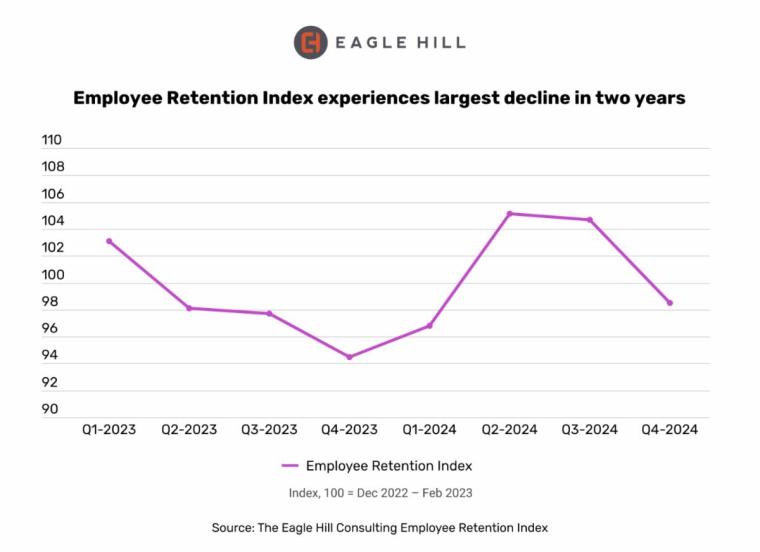
The latest Eagle Hill Consulting Employee Retention Index measures a substantial dip of 6.2 points to 98.5 for the fourth quarter of 2024, the first notable decline in 12 months and the largest in two years. While employee attrition rates had been falling in 2024, the Employee Retention Index signals that this trend could reverse in the new year with worker departures potentially heading upwards through mid-2025.
The Employee Retention Index follows two key U.S. economic reports, and the Index results are largely aligned with this new jobs data. The latest Bureau of Labor Statistics Job Openings and Labor Turnover Survey (JOLTS) data found U.S. job openings unexpectedly increased last November to 4.8 percent, the highest level of job openings since May. Meanwhile, the Department of Labor reported that hiring blew past expectations in December, adding 256,000 jobs in December while the unemployment rate ticked down to 4.1 percent.
“We’re seeing two important shifts in Eagle Hill’s latest Employee Retention Index,” said Melissa Jezior, president and chief executive officer of Eagle Hill Consulting. “First, workers are feeling more confident about their job opportunities — the biggest rise we’ve seen in two years. Second, worker satisfaction with their organization’s culture is deteriorating, with culture now a lagging indicator of retention. Taken together, there’s a substantial likelihood that employers may see a big jump in employee attrition in the first half of 2025, potentially ending ‘The Great Stay.’ While that may be good news for companies looking to reduce headcount, it could present a problem for employers facing chronic worker shortages.”
Looking at various demographics, the Employee Retention Index finds that women and Baby Boomers are most likely to leave their jobs in the coming six months. In contrast, workers who are most likely to stay in their jobs are men and Millennials. Generation Z is the only generation of U.S. workers more likely to stay in their jobs than indicated in the previous period.
U.S. Government workers’ Retention Index remains relatively stable in Q4, declining slightly by 1.6 points. The government Employee Retention Index (103.0) remains stronger than that of the American workforce (98.5). Comparatively, government employees report more optimistic views of their compensation and organizational culture than the average U.S. worker and less confidence in their organization and job market opportunities. It will be important to watch for shifts in this sector of the workforce as a new administration takes power on January 20th.
The Eagle Hill Employee Retention Index is a first-of-a-kind market indicator that provides employers with early signals of U.S. workers’ likelihood to leave or stay at their job. It tracks worker sentiment across four proven drivers of retention: organizational confidence, culture, compensation, and job market opportunity.
- The Organizational Confidence Indicator measures how confident employees are in their organization’s future and leadership. This indicator declined 4.5 points to 99.
- The Culture Indicator looks at employee sentiment about their workplace culture, connections, and whether they feel valued and recognized. This measure declined 3.1 points to 98.8. This is the lagging indicator, for the very first time.
- The Compensation Indicator measures how employees view their compensation, benefits, and ability to grow their compensation at their organization. For Q4 2024, this indicator decreased 7.9 points to 99.0, the largest decline to date and the largest dip among the indicators this period. In contrast, this indicator had ticked upward by 2.5 point in Q4 2023.
- The Job Market Opportunity Indicator measures how employees perceive external prospects for employment and job security in the near term. For Q4 2024, this was the strongest indicator for the quarter, increasing 3.1 points to 102.0, meaning workers are feeling the most confident about the job market and their external opportunities. This is the largest fluctuation in the indicator’s history, which has been more volatile in 2024 as compared to 2023.
Each month, the Eagle Hill Consulting Employee Retention Index measure shifts in workforce retention based upon ongoing employee opinion surveys on factors related to worker intentions to change jobs. As the Employee Retention Index increases, it signals an increase in retention in the next six months. As the Employee Retention Index decreases, it signals to employers that workers are more likely to leave their jobs, and organizations can expect more turnover in the next six months.
Understanding employee sentiment at a deep level has evolved into a competitive asset. With this new proprietary market indicator, employers have forward-looking insights to help proactively implement strategies to manage their workforce. While the Eagle Hill Employee Index isn’t a one-size-fits all for employers, organizations can use it to benchmark their organization and pinpoint their strengths and weakness. In doing so, employers can assess and make changes to ensure their workforce is motivated, engaged, and aligned with the organizational mission.
Results are released on a quarterly basis, including an annual summary report. Conducted by Ipsos, the Eagle Hill Employee Retention Index is a nationally representative sample of adults ages 18 and older who are employed full-time or part-time on a range of workforce topics. Survey data is collected on a monthly basis, which commenced in December 2022. The most recent data was collected from December 2 -3, 2024.

There are no comments
Please login to post comments